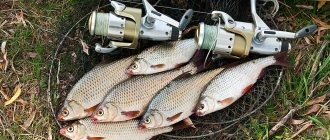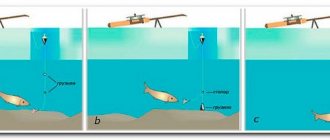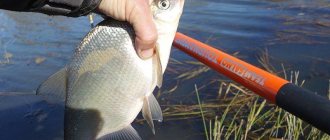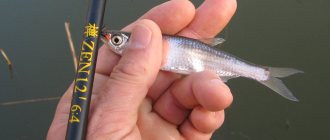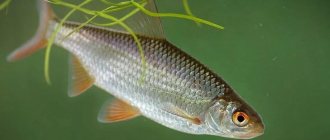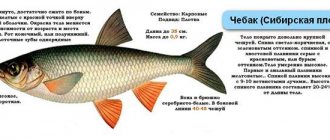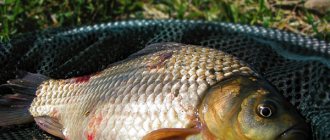Roach is considered the most common fish in our reservoirs, because it can be found in almost all bodies of water. The main condition for the life of roach is clean and running water, which is present in rivers, backwaters, lakes and large reservoirs. The fish prefers warm water; accordingly, its size depends on the climatic characteristics of the region.
The success of roach fishing in August can be influenced by a number of factors. Among them, the presence of other representatives of aquatic fauna in the reservoir, including silver bream and bream.
Techniques and techniques for catching roach in August
In August, the roach does not yet experience any particular shortage of food, but there are still fewer favorite delicacies. The fish move away from the shore due to the cooling water into deeper places, holes, pools, where they gather in small schools.
For a good catch of roach in the last month of summer, the following recommendations are useful:
- The best way to catch roach at this time of year is to fish with a float rod from the shore, boat or raft. To fish from the shore, you will need a longer rod and a float that is clearly visible from afar.
- The behavior of fish at the end of summer is greatly influenced by weather and changes in atmospheric pressure. Sometimes the roach stops taking bait completely. Most often this happens due to incorrectly chosen depth. Since this fish is very sensitive and capricious, its location in the water column can only be determined experimentally.
- According to the observations of experienced fishermen, roach bite intensively on quiet cloudy days without rain; the best time of day for this is morning and evening dawn.
Instinctively, the fish tries to “put on fat” for the winter, so it begins to give preference to food of animal origin. This is what you need to take advantage of.
If you feed the roach in one place for several days, you can get an excellent catch from there.
Search for fish
The food supply in the natural habitat of roaches is different - it can be a mosquito larva, small crustaceans, caddis flies or filamentous algae. Thanks to this omnivorous nature, roaches are caught using both animal and plant baits, and August is no exception. Although roach is very common, it also has favorite places where it prefers to stay. August is the time when roaches can be found in grassy backwaters and bays, in quiet reaches near pits.
On days when the heat continues to heat the water, the roach rushes to the depths, and on cooler days it hunts close to the shore.
Well, if we generalize everything, then we can say that roach can be found at different depths, but large fish stay deeper, and smaller ones are closer to the surface. The only advice to the fisherman: if there are no bites in a new reservoir after feeding for an hour and a half, then most likely there are simply no roaches here. Roach fishing in August is most stable in cloudy weather, in the morning and evening. Roaches do not respect sudden changes in weather and pressure surges.
Natural roach diet and effective baits
Roach is an unpretentious fish; it can find food in any freshwater body:
- From plant foods, she prefers green algae, the so-called “mud.” There is an opinion that roaches use it not only as a favorite treat, but also as a cure for diseases of the digestive system.
- Food of animal origin includes insect larvae, small crustaceans, and caddis flies. In August, the roach's diet consists mainly of them, since the amount of algae decreases by the end of summer.
To seduce this finicky fish when fishing with a float rod, you need to try several options:
- As live bait, you can use bloodworms, small grasshoppers, maggots, and houseflies.
- Vegetable baits include steamed pearl barley, barley, lentils, dough or bread pellets. To make them even more attractive, they are lightly soaked in fragrant oils.
Many fishermen note that roaches are strongly attracted to the red color, so the bait is often colored with red lead or food coloring.
It’s better to take several types of baits with you to a new place and experiment with them there. It happens that a fish only bites on one thing and ignores everything else. The preferences of roaches, even in the same body of water, can vary greatly.
fishing line
As the main fishing line for catching autumn roach, I most often use the Team fishing line
Salmo Fluorocarbon thickness 0.16-0.18 mm. How is it an unusual choice? Agree. But I use this line not because it is invisible in the water (although this factor also contributes to the fact that in clear water the fish are less afraid of the equipment), but because it is stiffer compared to other monofilament lines. In windy weather, a stiff line makes fishing more comfortable.
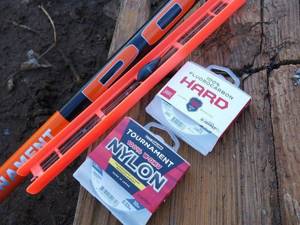
But I intentionally make leashes from soft Team Salmo TOURNAMENT NYLON fishing line with a diameter of 0.1 mm. It’s not scary that the strength of nylon fishing lines is slightly lower than their nylon counterparts (0.81 kg versus 1.09 kg) - for catching wary autumn fish, their amazing softness is much more important.
Feeding roaches
It is believed that without preliminary feeding (bait), a roach can only get hooked by accident.
Most often, this fish moves in a reservoir in schools, so with the right complementary foods you can pull fish after fish out of the water.
Roach is a small fish and quickly becomes saturated, which means it is important not to overdo it with bait. If the fish gets enough, you won’t be able to catch it with a fishing rod. To prevent this from happening, complementary feeding should be frequent and portions should be small.
Important conditions for effective complementary feeding:
- The bait should emit an attractive smell from a distance. For roaches, this is the aroma of roasted seeds, anise oil, cocoa, and caramel.
- The fish reacts positively to the whitish turbidity that appears during complementary feeding, which remains in a cloud for some time. For this purpose, powdered milk, corn flour and very finely ground flour of other grains are used in complementary feeding.
- Ideally, the auxiliary components of the bait should slowly soak in the water, smoothly sinking to the bottom, while freeing the most delicious component of the bait, which rises to the top. This could be bloodworms, maggots, bread crumbs, steamed grains, cereals. Such an active up-and-down movement interests the roach.
Features of the bait mixture
Bait is the most important component on which the final result of fishing largely depends. The bait mixture for roach should be very light and contain only small fractions. Most fishermen purchase ready-made bait, but professional fishermen prefer to independently select the composition of the bait mixture. Having learned to combine the components correctly, the angler will be able to prepare a mixture that ideally meets certain fishing conditions. The following components are usually used to prepare roach bait:
- breadcrumbs;
- corn flour;
- finely ground wheat bran;
- oatmeal (ground oatmeal);
- powdered milk;
- sunflower, hemp and coconut cake.
Particular attention should be paid to the process of moistening the bait. The degree of moisture should be such that the bait ball breaks into the water upon splashdown - this will create a vertical column of food particles in the water and quickly collect roach at the fishing point. To prevent the fish from leaving the fishing spot, the angler must regularly throw small balls of bait into the water, maintaining the resulting column of turbidity.

Adding animal components to bait increases the number of bites many times over.
The principle of feeding roach on the current is radically different from what is used in standing water. It is necessary to add heavy soil to the mixture for river fishing, which will prevent the food from being quickly washed away by the water flow. For river fishing you will need dense balls of bait that quickly reach the bottom.
The bait will work much more efficiently if you add to its composition those components that are used as bait. Small fish are better attracted to mixtures of light colors. Dark bait works well for large roaches. For a better attractive effect, various flavors can be added to the bait mixture. At the end of summer, caramel and chocolate flavors work better.
How do roaches bite?
Roach is a fisherman's favorite fisherman. An inexperienced fisherman may not even notice its bite. Often, the roach simply tastes the bait, very quickly drawing it into its mouth and instantly releasing it.
At the same time, the float only sways slightly on the water, as if from a breeze. Small roach are especially indecisive.
If there is a possibility that it is a roach that is biting, the fishing rod should be pulled out quickly, but without excessive sharpness. Wrong movements lead to the fish breaking off the hook, tearing its lips.
When fishing for roach, it is better to hold the rod in your hands and not put it on stands, otherwise you may miss the bite.
What to prepare bait for roach from?
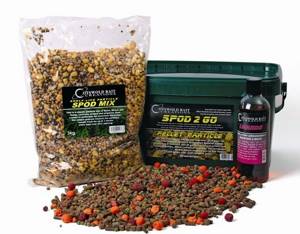
Any mixture to attract fish has a base, which is complemented by the sweet smell of a flavoring agent. In order to make the mixture more viscous and firm, baking powder is added. You can also put various additional food in it.
Typically, fishermen use macadamia, cereals or crackers as a basis. Flavorings are used as an attractant, which are also “branded” and sold in jars. But there are many natural attractants, for example, cinnamon, coriander, garlic, seeds, cocoa, vanillin. The viscosity of the bait mixture can be adjusted using soil, sand or clay.
Attention! To prepare bait, it is better to use soil from the place where the pond is located. The fish will sense a familiar smell and will swim towards it.
As additional food, you can add maggots, chopped worms or bloodworms. Experienced fishermen recommend mixing the bait at the fishing site, diluting it with water from the reservoir. It is strictly forbidden to use chlorinated water or tap water, as this can be a deterrent to roaches.
Advice! Good bait for roaches can even be obtained from halva, breadcrumbs, and mixed feed.
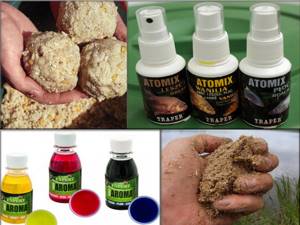
You can experiment and take any components, since the quality of attracting fish depends on the smell, which should be perceptible. Natural flavors can be used in a variety of ways:
- oils: anise, sunflower, hemp, coconut;
- sweets: cookies, biscuits, sugar;
- flour;
- semolina;
- seeds: sunflower, pumpkin.
Roach is a picky fish, so it is not necessary to use many components, a few will be enough. For quick results, you can even simply use bread or crackers, which must first be softened. Breadcrumbs, which are a common basis for feeding river fish, are also ideal, which applies not only to roach.
If you want to catch a large roach, then for the best effect, cook the porridge, mix it with various additives and add a delicious flavoring. This way you can attract not only roaches.
Roach fishing rod
If you plan to catch roach from the shore, then the following recommendations will help when choosing a fishing rod for it:
- The rod can be long (up to 2 fathoms), but it must be light. With a heavy rod in your hands, it is difficult to feel the uncertain bite of a roach. In addition, it is difficult to lift it quickly, and the fish may fall off.
- The fishing line you need to choose is thin (from 0.15 mm to 0.2 mm), but strong, and, as far as possible, inconspicuous (blue or green). Its length should be shorter than the length of the rod.
- A thin hook for roach is preferable - No. 3, No. 4.
- A float for catching roach needs to be light, sensitive, oblong in shape, and sinking deeply into the water. Long and light feather floats are undesirable, since when casting a fishing rod they slightly “float” above the water, making them more difficult to place in a precisely chosen place.
- The sinker can be one or in the form of several light pellets of different weights, located at a short distance from each other. The heaviest pellet should be furthest from the hook.
When fishing for roach from a boat, a long rod is of no use, and the rest of the equipment remains the same.
Nozzle
As mentioned above, roach is practically omnivorous and can be caught well on maggots, bloodworms, ant eggs, bran, caddis flies, small dung worms, grasshoppers, and dough with the addition of anise oil. When setting the bait, it is sometimes useful to leave the hook point sticking out a little, this will allow for a more reliable hooking. Sometimes, when fishing for roach in August, anglers use a jig instead of a sinker, this makes the tackle more sensitive.
When fishing for roach, you cannot hesitate to hook, it should follow even with a slight change in the behavior of the float, but you should remember that this fish has very delicate lips and with a very sharp stroke they can be torn and the fish will be lost.
Fishing in the “windows”
In August, roaches move away from the shore and move in schools into deeper water.
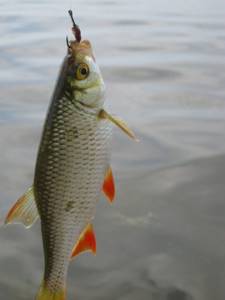
She also loves transparent holes (windows) in the middle of aquatic vegetation - water lilies, cattails.
In such a cozy “window” the fish is very comfortable:
- It is convenient to hide there from predators who cannot develop sufficient speed in the thickets.
- Between the stems of plants you can find a lot more food: algae, insect larvae, small fry.
- The water in the “windows” cools down more slowly, and roaches love warmth.
Such “windows” are also attractive for fishermen. Throwing a fishing rod there, with a high degree of probability you can expect a quick bite and catch.
For catching roach in “windows”, a fishing rod with the equipment described above is ideal.
The main thing is that it is convenient for accurately hitting the gap between vegetation.
Specifics of feeding roach at different times of the year
The process of preparing and using bait mixtures depending on the time of year.
The basic rules associated with the seasons are as follows:
- During the summer heat, anise seed is added to the bait; it can increase fishing productivity when there is a lack of oxygen in the reservoir, which negatively affects the activity of prey and the frequency of bites. At this time of year, an additional mixture of cocoa and caramel is often used, which is introduced into the bait.
- In late autumn and winter, it is recommended to include components of animal origin; chopped worms and maggots are suitable. Feeding bloodworms also increases the roach’s interest in bait; you can continue to use such recipes in March, when the fish have not yet become sufficiently active after the winter season.
- Ground daphnia are added to bait to increase its effectiveness in the autumn and spring. At this time, you should significantly limit the volumes of mixtures used in order to only attract the attention of the prey, but not to overfeed it. In autumn, it is recommended to avoid using strong-smelling attractants.
